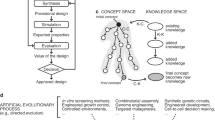Abstract
This paper discusses design families and design individuals. Phase space is introduced to complement state space. Phase transition as a generic method of generating design families is proposed and then demonstrated through an example of simple designs with one component. Based on phase transition in the biological world, a development model for complex designs (with multi-components) is established, by which different phase transitions for changing complex design families are analysed and simulated. Two concepts are drawn from the biological analogy: through gene mutation and regulation the individuals of complex design systems can be varied and searched within their state space; and by changing the interpretation process of genes, the families of such systems can be explored within their phase space.
Similar content being viewed by others
Author information
Authors and Affiliations
Rights and permissions
About this article
Cite this article
Shi, X., Gero, J. Design Families and Design Individuals. EWC 16, 253–263 (2000). https://doi.org/10.1007/s003660070008
Published:
Issue Date:
DOI: https://doi.org/10.1007/s003660070008




